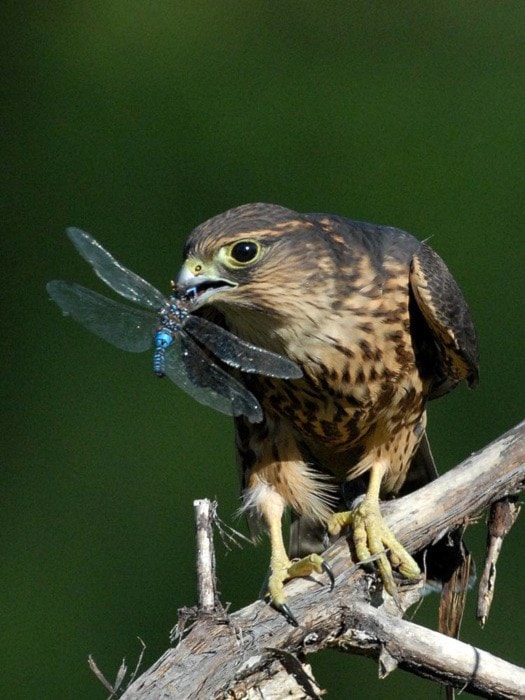One of my favorite members of the falcon family is the "magical Merlin."
Aerodynamically designed for speed, the Merlin is second only to the peregrine falcon, cruising at speeds in excess of 70 kilometres per hour.
Also known as the "pigeon hawk," this name not only implies their partiality to dining on pigeons, but also reflects the similarity in the air to the flight pattern of a pigeon with rapid wingbeats and lengthy swoops.
In olden times, Merlins were popular falconry birds particularly suited to ladies of nobility as they were easy for them to manage. In British Columbia, Merlins are migratory birds coming in the late spring and summer.
They prefer coniferous forests but are also found by lakes and ponds and along the shorelines. They are also becoming more common in urban areas, as they have adapted to backyard feeders that provide them with easy pickings.
Comparable in size to the stellar jay, the male Merlin has a slaty-blue/gray cap and wings, and a rufous-colored breast with dark streaks. Females are mainly dark brown.
In keeping with the falcon family, Merlins have sleek muscular bodies with pointed wings and long barred tails. Another unique feature shared by falcons is their specially adapted nostrils, which are equipped with pea-like baffles that reduce the impact of air rushing into the nasal cavity during high-speed flight.
These little falcons are extremely active and vocal, especially during the nesting season, emitting a piercing kee-kee-kee as they fiercely defend their territory.
Merlins spend little time perching as they capture their prey mid air coming to perch to devour their food. Once prey is spotted, the Merlin will relentlessly chase the prey, literally knocking it out of the sky with formidable talons; due to their power and speed they are able to attack a bird the same size as themselves.
Although birds are their main food source they will also dine on large dragonflies, insects and moths and the occasional rodent.
Unlike most raptors, Merlins do not mate for life nor do they build their own nests, preferring to reuse old crow or raven nests and will also use cavities in trees or cliffs. Although Merlins produce two to five eggs, usually only two will survive to adulthood.
Survival is often cut short by predation from crows and ravens and also eagles as they often choose nests that are in close proximity to eagles' nests.
The choice of nest for one Merlin family in Campbell River proved to be dangerous for the chicks as the eagles did attempt to snatch an easy meal and the chicks were found under the tree. A similar situation also happened in Courtenay, ending up with three chicks coming to MARS.
It has been several years since MARS rescued multiple Merlins and it seems that the increase of urban expansion is pushing them into more precarious nesting areas along with many other wildlife species.
Small falcons and hawks are difficult patients to rehab in captivity, especially the young as they need live prey to chase and capture a skill that needs to be passed on from the parents.
The Merlins, together with the osprey that was attacked in April, have been transferred to O.W.L. in Ladner where they have foster parents and large flight pens to condition the birds for their hopeful return and release in the Comox Valley.
A sad update saw the tiny great blue heron lose its struggle for survival. It really was an uphill battle for such a tiny specimen but hopefully we gained valuable experience in the rehabilitation of any future cases.
On a final note, we are sending out a seal pup alert.
These marine mammals are now giving birth to their pups and already we have admitted "kidnapped" babies. Please remember that mother seals will beach their pups to go off hunting, returning on the high tide.
Do not pick up pups! If in any doubt, call MARS' emergency line at 1-800-304-9968 for advice before intervening. Keep dogs and people away from the pups.
• • •
A huge thank you to all the teachers and students who supported MARS' educational programs over the last school year. I look forward to seeing you all again in the coming year.
For all other calls, phone 250-337-2021 or visit our website at www.wingtips.org.
Sandy Fairfield is the educational co-ordinator for the Mountainaire Avian Rescue Society (MARS). The MARS column appears every second Friday.
